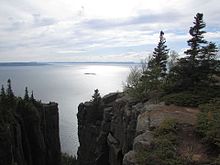Sleeping Giant Provincial Park
| Sleeping Giant Provincial Park | |
|---|---|
Thunder Bay District, Ontario | |
| Nearest city | Thunder Bay, Ontario, Canada |
| Coordinates | 48°20′14″N 88°54′16″W / 48.33722°N 88.90444°W |
| Area | 243.91 km2 (94.17 sq mi)[1] |
| Established | 1944 as Sibley Provincial Park |
| Governing body | Ontario Parks |


Sleeping Giant Provincial Park, established in 1944 as Sibley Provincial Park and renamed in 1988, is a 244-square-kilometre (94 sq mi) park located on the
The park occupies most of the lower portion of the peninsula excluding the area around the seasonal community of Silver Islet, and a portion of Thunder Cape which is designated as the Thunder Cape Bird Observatory.[2] The eastern portion of the park is lowlands, while the western half is composed of cliffs, valleys, and the mesa–cuestas which make up the Sleeping Giant formation. At its eastern edge, the park borders the Lake Superior National Marine Conservation Area.
Geography
The Sibley Peninsula is 52 kilometres (32 mi) long and 10 kilometres (6 mi) wide. It projects into Lake Superior from the
Ecology
The varied terrain and the effect of Lake Superior on the peninsula's microclimates provide habitats for a wide variety of plants and animals.
Plants found in the park include 23 species of
Wildlife found in the park includes a wide variety of mammals. The most dominant species are
Activities
Sleeping Giant Provincial Park offers numerous recreational activities. The park has more than 100 kilometres (62 mi) of trails, the longest being the 40 kilometres (25 mi) Kabeyun Trail.
Facilities
The park has several
can be rented from the park store.Natural Heritage Education
Sleeping Giant Provincial Park is part of the
References
- Ontario Parks Sleeping Giant Background Information (2003) Queen's Printer for Ontario. ISBN 0-7794-3989-9. Retrieved on 26 September 2007.
- ^ Sleeping Giant Background Information, 2.0 Background Information, Overview, pp. 4.
- ^ Sleeping Giant Background Information, 2.0 Background Information, Figure 2 - Adjacent Land Use, pp. 6.
- ^ Sleeping Giant Background Information, 3.2 Earth Science, Topography, pp. 11.
- ^ Sleeping Giant Background Information, 3.3 Life Science, Significant Plant Communities, pps. 22–23.
- ^ Sleeping Giant Background Information, 3.3 Life Science, Wildlife, pps. 24–26.
- ^ Sleeping Giant - Hiking Archived 2012-09-07 at archive.today. The sum length of all trails is 103.1 kilometres (64.1 mi). Retrieved on 26 September 2007.
- ^ Sleeping Giant - Facilities and Services Archived 2007-10-30 at the Wayback Machine. Retrieved on 26 September 2007.
- ^ Sleeping Giant - Park Activities Archived 2007-10-30 at the Wayback Machine. Retrieved on 26 September 2007.
- ^ Sleeping Giant Background Information, 4.0 Inventory and Evaluation of Cultural Resources, interpretive Assessment and Themes, pp. 27.

